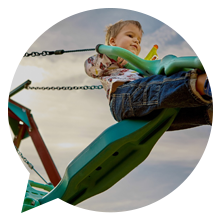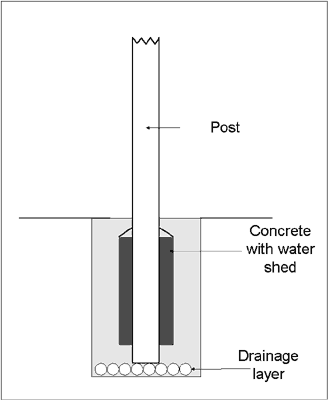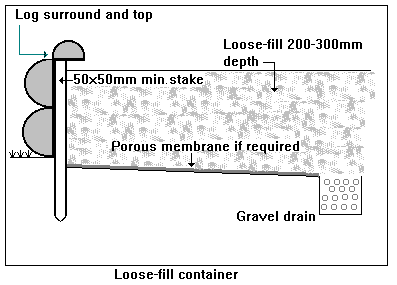Construction notes for self-build play equipment

Introduction
These notes are intended for small unsupervised playgrounds in villages or other situations of light use.
Metal
As a general principle, metal should be avoided unless for handgrips.
Timber
Choose timber with many annual growth rings close together. It should be pressure treated with an appropriate preservative. CCA (Copper Chrome Arsenic) treatment is not allowed. Scots Pine is best with Spruce Norway as an alternative. Avoid Douglas Fir, Corsican Pine and Larch. For parts with heavy wear (rungs, over-head bars etc.) use hardwood such as Ash or Oak (preferably from renewable sources).
If properly treated up to 15 years in-ground life should be expected. Main uprights and support members should be not less than 150mm diameter. Use half-round timber for cladding only. Sawn timber should be used for boarding and walkways.
Do not use second hand timber (including telegraphy poles) or timber from demolition sites.
In some circumstances reference can be made to BS 5268 'The Structural Use of Timber' Part 2.
All equipment should be designed to meet BS EN 1176.
Plywood
Marine ply should meet BS 1088 or EN 636, part 3 as appropriate. Cut edges should be sealed.
Preservatives
Use timber pre-treated with a preservative meeting BS 5589 Section 6.
Suppliers of timber should be told of its use and any surplus salts should be removed by high pressure water jet and scrubbing. Coloured finishes should be non-toxic.
Fixings and fastenings
The main reliance for strength should be on the use of natural forces (gravity and mechanical forces).
Studding should not be used less than 100mm from the ends of timbers. Unless holes are pre-drilled screws should not be used less than 200mm. Holes should be centred and not near the edges. Fixings should be easily replaceable and, if practicable, a plastic sleeve should be used. Brass or stainless steel (type 302) fixings are the most suitable.
Studding and coach screws should always be recessed below the surface and covered by a dowel plug or hard setting external mastic to discourage tampering. Use Nyloc nuts.
Drill a pilot hole for coach screws. For woodscrews use 12 gauge A2/303/304 material and drill a 2.5mm pilot hole.
Few glues are satisfactory for outdoor long-term use.
 Jointing
Jointing
Badly cut joints can cause loss of strength or allow water and micro-organisms to enter and cause decay. Jointing between poles require both faces to be made square or shaped to fit each other. Treat cut (and drilled) surfaces with preservative.
Construction should be such that there are no unexpected projections (EN 1176) which could be a hazard.
Installation
(Without concrete)
Main uprights should have 40% of their length in the ground - in light or unstable grounds increase to 50%. Dig a narrow hole (preferably with a hand or tractor auger). (Holes over 1m deep into which the digger descends must be shored up to prevent collapse). Ram the bottom firm and put in a 100mm layer(when compacted) of hardcore (max. size 50mm diameter). When the pole is correct, fill with alternative layers (100-150mm) of well-compacted soil and hard-core (brick rubble is recommended). Use an earth rammer for compaction. Avoid clay soils if possible.
(With concrete)
If you must use concrete (for example, where there is a high water table, unstable soil or over-large post hole), put a 100mm compacted layer under the pole and backfill with concrete to 150mm beneath surface.
Shape the top of the concrete away from the pole to provide a water shed. There must be no concrete under the pole to stop drainage. Use a 'no-fines' mix of one part sulphate resisting cement to six parts aggregate (20mm max. diameter). Rapid hardeners should be avoided if possible. Sides of the pole below ground should be coated with bituminous paint. There are specific depths given in BS EN 1176.

Safety surfaces
Where a rubber surface is provided - use a professional installer. Loose fill materials (bark, sand etc.) can be laid in a pit or box.